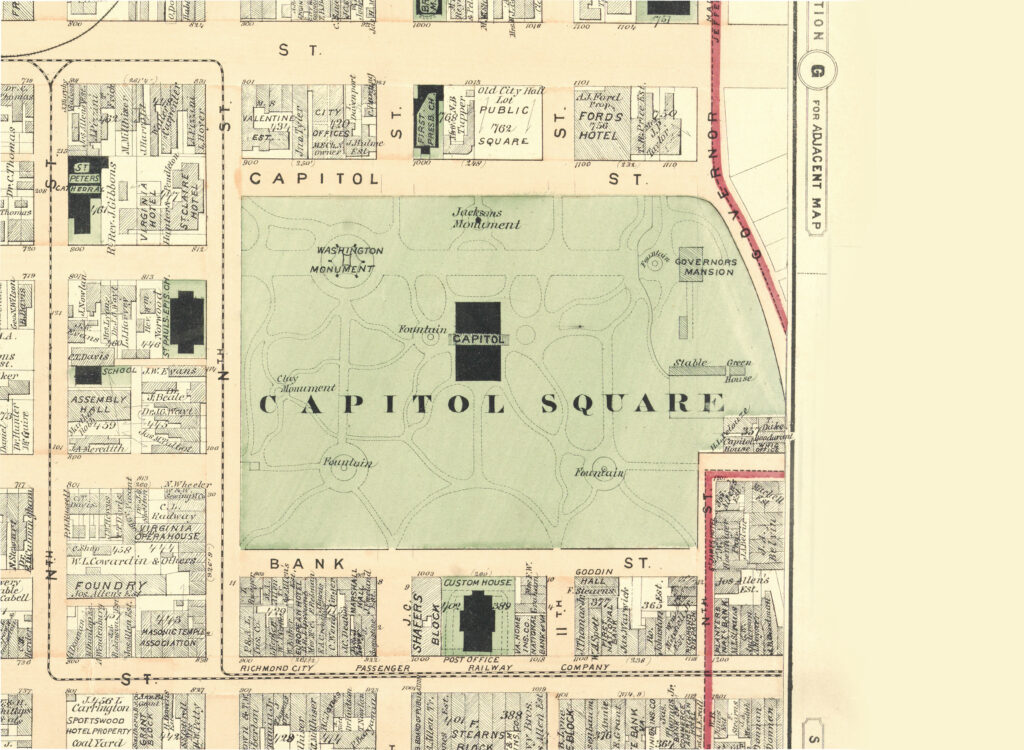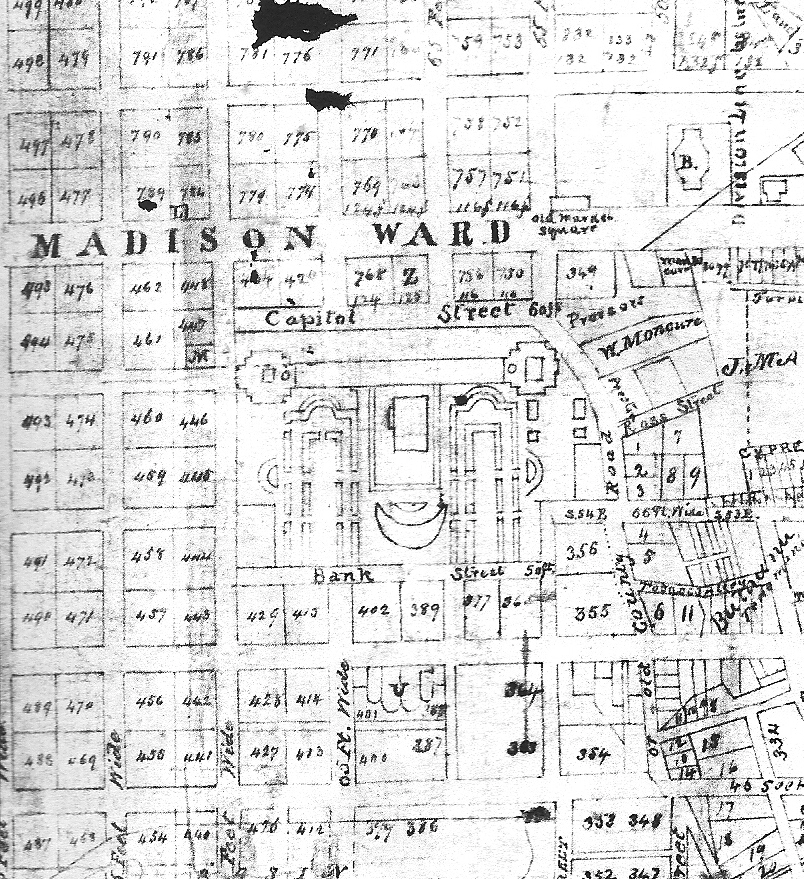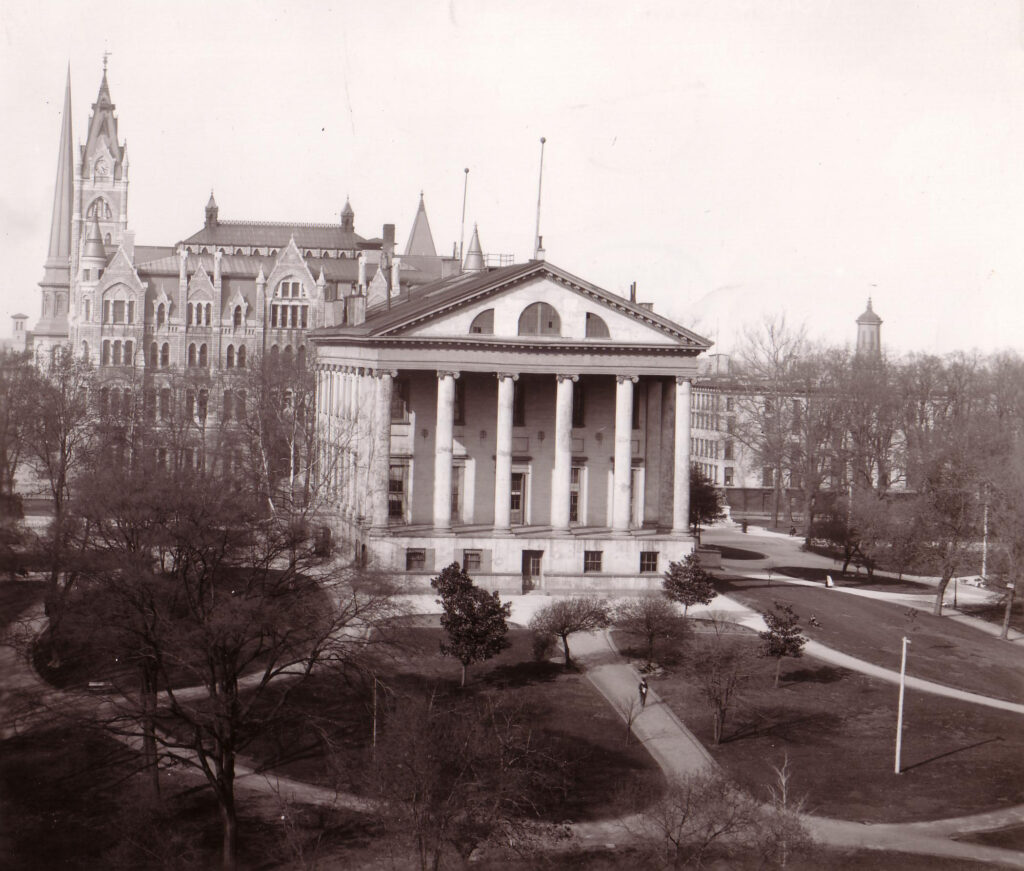Capitol Square
Capitol Square in downtown Richmond spans 12 landscaped acres, enclosed by a historic cast-iron fence dating back to 1818. Today, it serves as both a public park and civic campus, home to state government buildings, monuments, gardens, and art installations. Visitors can explore scenic walkways, shaded green spaces, and a wide range of memorials honoring Virginia’s leaders, citizens, and cultural heritage.

Public Buildings
- Executive Mansion – The nation’s oldest continuously occupied governor’s residence, completed in 1813, located east of the Capitol.
- Oliver Hill Sr. Building – Built in 1893 as Virginia’s first state library; now houses the lieutenant governor and other state offices.
- Washington Building – A 12-story state office building on the southeast corner of the Square, completed in 1924.
- Capitol Bell Tower – A brick tower in the southwest corner, initially built in 1825 for the Virginia Public Guard. It still rings to signal the start of General Assembly sessions.
Monuments & Memorials
- George Washington Equestrian Monument – A massive bronze-and-granite memorial surrounded by statues of Virginia patriots like Patrick Henry, Thomas Jefferson, and John Marshall.
- Virginia Civil Rights Memorial (2008) – Honors activists from the 1950s–60s, including Barbara Johns, Oliver Hill, and Rev. Leslie Griffin.
- Mantle (2018) – A Native American earthwork monument incorporating river stones and indigenous plants.
- Voices from the Garden: Virginia Women’s Monument (2019) – Features bronze statues of 11 women, including Maggie Walker, Martha Washington, and Virginia Randolph, representing over 400 years of women’s contributions.
- Memorial Trees – Dedicated to leaders such as Washington, Governor Darden, Governor Robb, and Martin Luther King Jr.
Gardens & Landscape

Capitol Square includes winding walkways, shaded lawns, and a mix of 19th- and 20th-century design features. It is considered one of the earliest planned urban parks in America, predating New York’s Central Park.
Darden Garden: The Colgate Whitehead Darden, Jr. Memorial Garden, created in the 1980s after Capitol Street was closed to traffic, provides a quiet green space with walkways and plantings. It connects the General Assembly Building and the Patrick Henry Building. Dedicated in 1983, it honors Colgate Darden, a Virginia governor and president of the University of Virginia.
Visitor Experience
- The Square is open to the public and often hosts official ceremonies and civic events.
- More than 100,000 visitors walk the grounds each year, exploring monuments, gardens, and the landscaped park.
Landscape Design

The public area surrounding the 1788 Capitol was originally a weed-filled, virtually treeless open square with informal lanes and footpaths. The first formal landscape plan for Capitol Square was developed by Maximilian Godefroy in 1816. His formal walkways, public fountains, and trees planted with geometric precision recalled the courtly gardens of 18th-century France. In 1850, John Notman was hired to redesign the landscape of Capitol Square. He introduced informal winding paths, additional public entrances, and new plantings of trees in scattered groups. Notman’s plan was implemented in the 1850s, making Capitol Square one of the first major urban parks in the nation designed in the English picturesque style. The current landscaping of the grounds reflects various elements of the previous 19th and 20th century designs used on the Square. As a planned urban park, Capitol Square is older than Central Park in New York City.
Notable Visitors and Events Through The Years

For more than two centuries, Capitol Square has been a place of political power and public inspiration, attracting local citizens and foreign dignitaries alike. The Marquis de Lafayette, a French General who served with distinction in the American Revolution, was an honored guest on the Square in 1824. In April 1865 Abraham Lincoln toured the Capitol and grounds near the end of the Civil War. Teddy Roosevelt addressed a crowd gathered in Capitol Square in October 1905. Winston Churchill was a guest at the Executive Mansion in October 1929. He returned to Capitol Square in March 1946 and gave a speech to a joint session of the Virginia General Assembly. Margaret Thatcher addressed the Virginia General Assembly on the topic of “liberty” in February 1995. In May of 2007, Her Majesty Queen Elizabeth II also visited the Capitol grounds and gave an address to a special joint session of the Virginia General Assembly.
Capitol Square has long served as a familiar setting for inaugurations. In February 1862 Jefferson Davis was inaugurated here as the only elected president of the Confederacy. For most of the 20th century, Virginia governors have taken their oaths of office in outdoor ceremonies every four years. In January 1990 Lawrence Douglas Wilder was sworn in as the first elected African-American Governor of a U.S. state and Mary Sue Terry, the first woman elected to executive office in Virginia, was inaugurated for her second term as Attorney General.

Virginia’s historic Capitol Square in downtown Richmond is an architectural and artistic setting for events shaping America’s individual liberties, political institutions, judicial traditions, and social progress. Government buildings and public monuments on the Square are reminders of power, leadership and enduring principles. The twelve acres of landscaped grounds are enclosed by an original and distinctive 1818 cast iron fence–one of the earliest of its kind in the country. The historic grounds and buildings of Capitol Square are recognized as an ideal downtown location for legislation, inauguration and commemoration. Capitol Square remains an active public park and civic campus for self-government in the Commonwealth of Virginia. The twelve acres of landscaped grounds are enclosed by an original and distinctive 1818 cast iron fence–one of the earliest of its kind in the country. The historic grounds and buildings of Capitol Square are recognized as an ideal downtown location for legislation, inauguration and commemoration. Capitol Square remains an active public park and civic campus for self-government in the Commonwealth of Virginia.
